QuestionHi Diane
I have two leopard geckos for about 7 months now they have been thriving and doing wonderfully but about two months into owning them i noticed the smaller gecko (female i am guessing)was not getting her share of crickets and was not growing as much as my larger gecko. when I dropped them (the crickets) in the tank the larger one would gobble them all up while the smaller one was still trying to get one. My solution for this was to feed the smaller one mealworms from a pair of tweezers while the larger one was hunting down the crickets. Eventually they both caught on to the tweezer method and began fighting over mealworms so i had to distract one with mealworms while I fed the other. eventually both Geckos have lost interest in crickets when they see me walk up to their tank the both look straight up waiting for mealworms. they don't even attempt to chase crickets and dont even seem to look at the ground when i drop mealworms in for them! now for the last week and a half I can barely get either one of them to eat ANYTHING they might eat one or two mealworms from the tweezers every couple of days. I figured with my smaller gecko it was because she was shedding pretty badly on her face for a few
days and having trouble getting her skin off with moist hidespot and all but she is done shedding now and still wont eat HELP!! what do I do??
Paul (Sorry for the long question!!)
AnswerHi Paul,
My first suggestion is to give each leo their own tank and set up. They do much better when they have their own space. The difference in their size is one of the first signs of stress of housing together. What you may have is two males, or even two females..or even male and female there can be stress factors.
Sounds like the "kids" have gotten very used to having their food handed to them...been there..done that!! In other words, they have gotten lazy!!! One trick with lazy geckos and crickets is to break the lower part of their legs off so they don't hop. Try offering a few wax worms(not a staple, only a treat) from a dish with a few of the mealworms in there also. You may have to make the worms move a bit to get the leos attention. They do need and look for some variety in their diet.With them getting older, they will generally eat less often..usually every other day. Mine will go though times where they will only eat a few insects every few days and then go through stages where they eat a dozen insects in one sitting.
With meal worms, they have so much hard outer body it can cause a bit of a blockage in the leos. Make sure they are going to the bathroom
Offer some water from an eye dropper. Usually just dripping it on their nose will cause them to lick at it. Also, other things like some baby food chicken or fruits(prunes help if a bit blocked) can be given the same way. Just a dab on the nose near the mouth will cause them to lick at it. If she hasn't shed completely, (check toes) you can use a wet cotton swab and gently rub the shed. If it does not come off you can apply a small amount of Vaseline to the stuck shed. Be careful around the nostrils though.
Do move each to their own tank so they each have their own space. I've included a basic care sheet on the leo so you can see some ideas for housing, temperatures and diet.
BASIC CARE FOR A LEOPARD GECKO
Leopards are pretty easy to care for but they do need
special care. Here are some of the basic needs of your
gecko.
HOUSING: The need to have at least a 20 gallon long tank for
one Leo. This needs to have a secure fitting screen top...they can be quite the escape artists!!! They need to have a humid hide box.You can make
this with something as simple as a small plastic dish with a
hole cut in one side and a small mesh bag filled with some
Sphagnum moss, coconut bark or Peat moss that you mist.
I made mine out of the small plastic folgers coffee containers...I cut an opening in the lid..and put the moss in..they LOVE it. I use the terrarium moss in mine.
I use that on the warm side of the tank. Be sure to provide a cool hidebox on the other end. I also provide a mid temperature hide...which is in the middle of the tank.I use the critter caves which you can purchase. NOT the ones that have heat in them!!!!
Provide secure climbing areas for your gecko. Fake plants, rocks and branches are all fine to use. be sure there are no wires or sharp ends to any fake plants you use.
*****SUBSTRATE:(that's the stuff on the floor of your tank) Newspaper, lizard carpet or paper towels work great and are easy
to clean and are much safer than any loose substrate. Sand or other loose substrate is not recommended as that they can be deadly to the leo when it is ingested(eaten, even by accident while eating their insects)... ******What I have found that works great for safety and heat distribution is using about 1/4 inch of childrens play sand(since the tiles fit tight together, there is no sand danger) on the bottom of the tank and on top that you place ceramic or slate floor tile. What is nice is that the 12 x 12 squares fit perfect in a 20 gallon tank with no spaces between the tiles. The sand and the tile distribute the heat wonderfully. Using the under tank heater as described is what distributes the heat. Also, overhead heat will help in heating the tiles...I've been using this set up for several years and the leos love it. Using a tile that isn't smooth is recommended. **********
TEMPERATURES: They need a warm area of 88-92 degrees and a
cooler area in the upper 70s, low 80s. At night their
temperature can drop to the low to mid 70's.
Never use a hot rock for a leopard gecko...or any reptile.
They can severely burn any reptile. You can use a heating
pad under the tank,under tank heater, or you can use a regular household
lightbulb in a dome fixture with a ceramic socket in it to
keep the warm area at the 88-90 degree area.At night, no white light. If room temperatures stay above 70 degrees, no extra night heat is needed. The undertank heater or heating pad should cover about 1/3 of the tank....be sure to raise the tank up about 1/4-1/2 inch off the stand when using an undertank heat source to prevent heat build up which can cause the glass to break and hot spots in the glass. Be sure to have a good layer of newspaper, carpeting or, even a thin flat rock(such as tile) on top the area that the undertank heat source is placed...if you use a thin rock or tile, it helps to distribute the heat very well.
You can use the special nighttime lights that are designed for reptiles. I like using a ceramic heat emitter on a thermostat for nighttime heat.
DO NOT use black lights or party lights as they can cause eye damage!!!!
The wattage you use will vary based on room temperature and size of tank.
LIGHTING: Leopard geckos do not need UVB lighting but it does not hurt them to give them uvb. They should have some type of light during the day, be it a uvb tube, regular florescent light, reptile day light or regular household lightbulb. NO white lights at night!!!
FEEDING: Geckos should not be fed crickets or other insects that are bigger than the space between their eyes. Generally, hatchlings can be fed more than once a day,juvys can be fed twice a day, adults are fed once daily or every other day, in the early evening. Crickets and other food items such as silk worms, super, and an occasional treat of a wax worm, need to be dusted with a calcium supplement two times a week and also they should have a small dish of calcium in their tank. I use the lid of a milk jug for the little dish of calcium in their tank. For dusting the insects, Use a calcium with no added phosphorus.
Insects must be gut loaded(fed) for at least 48 hours prior to feeding your gecko. Remove any uneaten crix or superworms after 15-20 minutes..... Place a piece of cut potato in the tank so that if you have missed any uneaten insects, they will eat the potato instead of nibbling on your gecko!!!
*************You have to be sure to feed your crickets and insects the right foods
before feeding them to your gecko. If your crickets/insects are not healthy and well fed, your gecko will not get the nutrition
he needs. You can gut load your crickets and insects greens, veggies, cereals or specially designed commercial foods for crickets or the insects you are feeding. ************
Be sure to have a small dish of clean water for your gecko
at all times!!
You can offer them some baby food or fruits on occasion ...
Mine will even eat a small piece of watermelon now and then.
WATER: always provide a dish of drinking water. If you choose to mist your gecko to drink, its best to not get the tank too wet as that they do not do well with higher humidity. Sometimes its better to take your leo out of their tank to mist them to get them to drink!!!
HANDLING: Some geckos enjoy being held...others prefer not to be handled at all. Be sure to be very gentle when holding your leo and NEVER grab them by the tail! Their tails are extremely fragile and will break.
I do suggest finding a vet that can treat reptiles BEFORE you actually need one!!! To find a vet that is able to care for reptiles:
http://www.anapsid.org/vets
http://www.arav.org/Directory.htm
For more information on leopard geckos:
http://www.thegeckospot.com/leocareindex2.html
http://www.drgecko.com
If you have any more questions, or don't understand something, please let me know
Double check your temperatures. With outdoor temperature changes, indoor temps change drastically and any drafts will lower the temps even more.

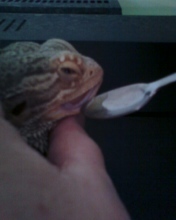 Bearded Dragon Eyes
QuestionBearded Dragon Eyes
QUESTION: Hi Tracie,
Bearded Dragon Eyes
QuestionBearded Dragon Eyes
QUESTION: Hi Tracie,
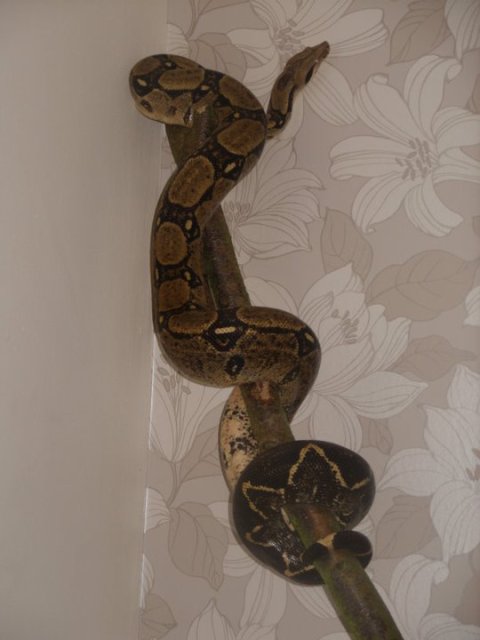 boa behaviour change
Question
Tink Our Snake
Hi, we have what we think is a
boa behaviour change
Question
Tink Our Snake
Hi, we have what we think is a
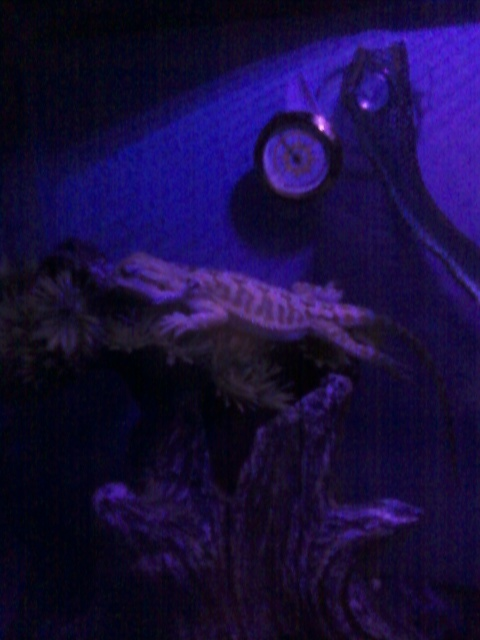 Walking strange
QuestionQUESTION: Hi Tracie,
We have a 9 month old bear
Walking strange
QuestionQUESTION: Hi Tracie,
We have a 9 month old bear
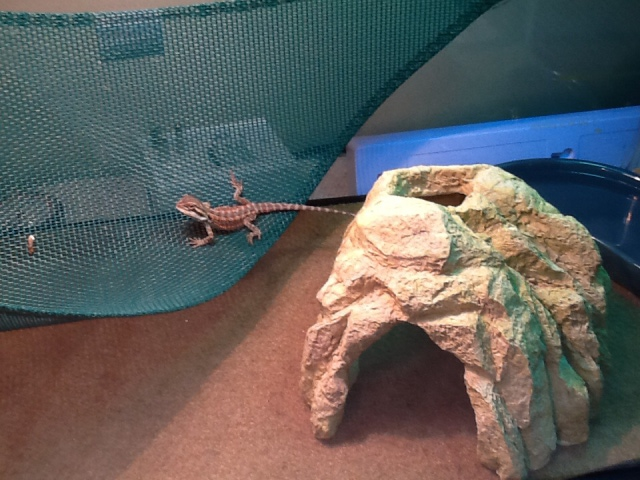 Getting my baby beardie to eat
Question
Bogie
Ive had an 8 week old baby beardi
Getting my baby beardie to eat
Question
Bogie
Ive had an 8 week old baby beardi
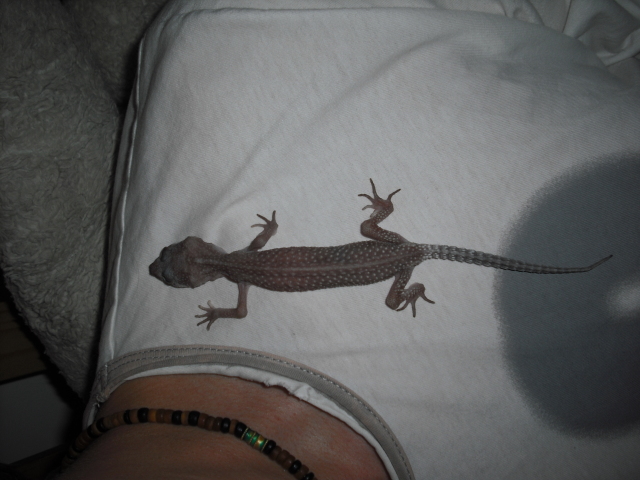 Leopard Not Eating
QuestionQUESTION: We have 3 leopard geckos. We have had
Leopard Not Eating
QuestionQUESTION: We have 3 leopard geckos. We have had